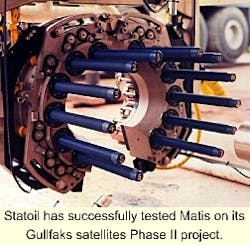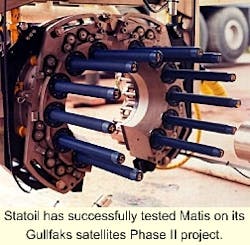Statoil, after tests on its Gullfaks Satellites Phase II project, has adopted a new subsea tool that allows flanged piping to be assembled in deep water without diver assistance.
Developed in cooperation with Stolt Offshore, the new remote-control technology is called "Matis" for "modular advanced tie-in system" (Fig. 1).
The tool was tested on four pipelines in 215 m of water on the Gullfaks Satellites Phase II project. The pipelines, 22 and 24 in. OD, were tied back to Gullfaks C with the help of the new tool.
Statoil says it forms a part of its pipeline-repair system (PRS), a collection of tools for repairing and connecting pipelines developed in cooperation with Norsk Hydro and held at Killingøy north of Stavanger.
"This solution is far cheaper than the methods we've had available in recent years for mechanical tie-in," says project manager Jan Olav Berge.
"It also represents an alternative to hyperbaric welding, which still requires the involvement of divers."
Gulfaks development
The Gullfaks satellites-Gullfaks South, Rimfaks, and Gullveig-are being developed as satellites to Statoil's Gullfaks field in the Norwegian North Sea. A total of 10 subsea templates are tied back via flow lines to the Gullfaks A and C platforms.
Phase I, with a producing capacity of 125,000 b/d, began flowing from all three fields in October 1998. Phase II encompasses natural-gas recovery with associated oil and condensate from the Brent reservoir in Gullfaks South and is due on stream in October 2001.
Statoil has estimated total field recoverable reserves at 371 million bbl of oil and 54 billion cu m of gas.
Partners are Statoil (operator, 18%), the Norwegian state's direct financial interest (73%), and Norsk Hydro (9%).



